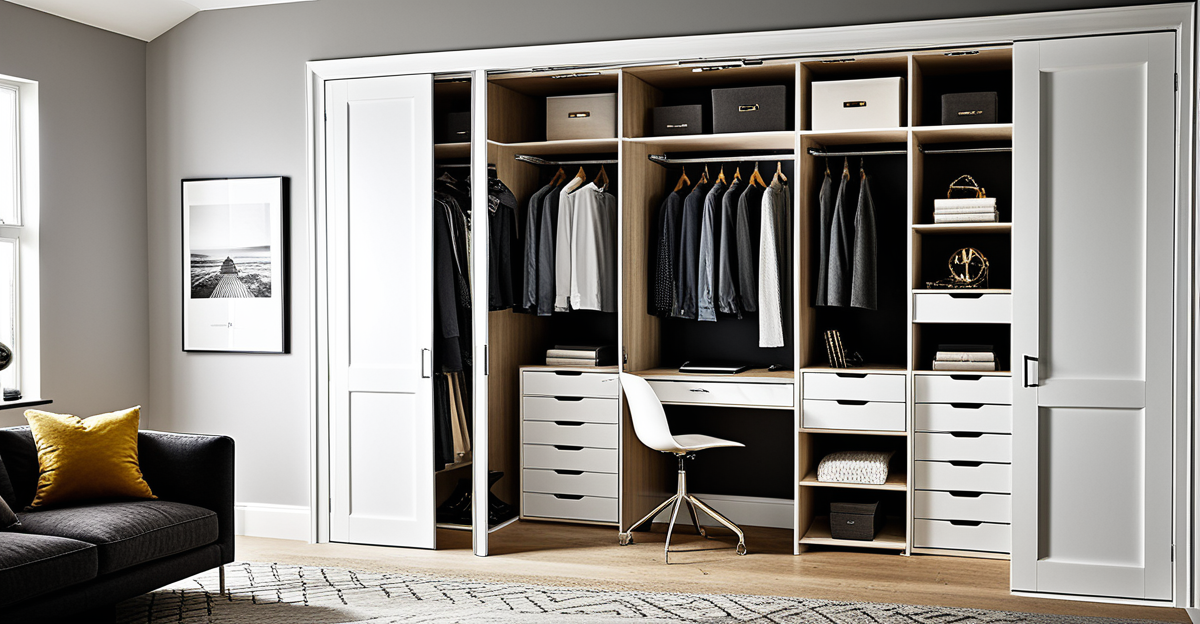Essential Steps to Convert a Closet into a Functional Home Office
Transforming a closet into a closet office conversion begins with assessing the dimensions and layout of the available space. Structural considerations are crucial—checking for adequate ventilation, lighting, and electrical outlets helps shape the home office setup. For UK homes, attention must be paid to wall thickness and any potential moisture issues common in smaller spaces.
The DIY conversion process generally starts with clearing the closet and measuring precisely to design a functional layout that maximises every inch. Installing a sturdy desk surface is often the first practical step, followed by adding shelves or pegboards for vertical storage. In small space solutions UK contexts, fold-down desks or wall-mounted units can be particularly advantageous to save room.
Topic to read : Transform your uk barn: the definitive guide to creating a stylish and cozy home retreat
Essential tools and materials include a drill, screws, wall anchors, brackets for shelving, and paint or wallpaper for aesthetic uplift. Additionally, selecting compact furniture tailored for tight spaces can enhance both functionality and comfort. Incorporating adjustable lighting fixtures and power extensions should not be overlooked to ensure an effective home office setup.
By systematically following these steps, you can create a workspace that fits seamlessly into a modest closet while addressing the unique size and design challenges found in many UK homes. This method ensures a precise and well-organised transformation.
Also read : Revamp your small uk entryway: stylish and practical shoe storage solutions for space optimization
Essential Steps to Convert a Closet into a Functional Home Office
Creating a closet office conversion starts with a precise assessment of the available space. Measure your closet meticulously, noting height, width, and depth, to determine feasible layouts. Structural considerations should include ensuring proper ventilation and confirming that walls can support shelving or mounted desks. For a home office setup in UK homes, wall thickness and moisture levels must be evaluated to avoid future damage.
The DIY conversion process involves a clear sequence of steps. First, clear out the closet entirely and prepare surfaces by cleaning or repainting. Next, install a desk surface suited to your closet’s dimensions—consider fold-down desks for added flexibility, a popular choice within small space solutions UK. Then add storage elements like shelves or pegboards, which optimise vertical space without crowding the floor.
Necessary tools include a power drill, screws, and wall anchors designed for masonry or drywall common in UK constructions. Materials such as brackets and paint provide both function and style. Ensuring your home office setup has accessible electrical outlets is crucial; plan power extensions or USB hubs if needed. These careful preparations and considerations form the backbone of a successful closet office conversion tailored specifically to UK homes.
Essential Steps to Convert a Closet into a Functional Home Office
Converting a closet into a practical home office setup begins with thoroughly assessing the available closet space. In UK homes, this means measuring dimensions accurately and considering factors like wall thickness and ventilation. Structural integrity must be confirmed to ensure shelves and mounted desk components can be securely installed, an essential step for a successful closet office conversion.
The DIY process involves a clear, step-by-step approach tailored to maximise efficiency in small spaces. Start by clearing the closet and treating surfaces, then install a desk surface adapted to the space—fold-down or wall-mounted desks are ideal small space solutions UK homeowners favour. Adding vertical storage such as shelves or pegboards optimises every inch without cluttering the floor.
Essential tools include a power drill with masonry or drywall bits, suitable screws, and wall anchors designed for UK construction standards. Materials should feature sturdy brackets and appropriate finishes that withstand typical UK moisture levels. Additionally, plan for electrical needs by incorporating power strips or USB hubs, ensuring the home office setup is functional and safe. This methodical approach guarantees your closet office conversion balances practicality with comfort effectively.
Essential Steps to Convert a Closet into a Functional Home Office
Begin your closet office conversion by thoroughly assessing the available space. Measure height, width, and depth precisely, considering how UK-specific features like wall thickness and ventilation impact the project. Structural factors, such as ensuring walls can hold shelves or a desk securely, are vital to maintain stability and safety.
The step-by-step DIY approach starts with clearing and preparing the closet interior. Surface treatment—cleaning or repainting—enhances aesthetics and durability. Installing a desk suited to the dimensions is next; small space solutions UK often recommend fold-down desks to save room effectively. Adding vertical storage, like shelves or pegboards, optimises space without encroaching on floor area.
Tools and materials essential for this transformation include a power drill with appropriate bits for UK walls, masonry or drywall screws, and robust wall anchors. Brackets and quality paints provide functionality and a polished look. Electrical considerations are critical—plan for accessible sockets, possibly adding power extensions or USB hubs to support a reliable home office setup. Combining these elements creates an efficient, comfortable workspace tailored to the specific challenges of UK closet spaces.
Essential Steps to Convert a Closet into a Functional Home Office
Begin your closet office conversion by precisely assessing the available closet space, focusing on height, width, and depth. This ensures your home office setup fits comfortably without feeling cramped. Structural considerations include verifying wall integrity, particularly for mounting shelves or desks, critical in UK homes where wall thickness varies. Ventilation is also essential to create a comfortable workspace and prevent moisture build-up common in smaller areas.
The DIY process unfolds step-by-step, starting by clearing the closet and preparing surfaces for installation. Measuring carefully allows you to design a layout that leverages small space solutions UK experts recommend, like fold-down desks or wall-mounted shelves that free floor space. Prioritise vertical storage to maximise the usable area efficiently.
Selecting the right tools and materials is crucial. You will need a power drill compatible with UK wall materials, masonry or drywall anchors, sturdy screws, and brackets to support shelves and desk units. Quality paint or finishes protect surfaces from moisture while providing a polished look. Plan electrical needs early to integrate power outlets or extension cords safely, ensuring your home office setup is functional and reliable within the constraints of your closet conversion.
Essential Steps to Convert a Closet into a Functional Home Office
Start your closet office conversion by carefully measuring the closet’s height, width, and depth. This is fundamental for designing a home office setup that fits snugly without compromising comfort. In UK homes, evaluating wall integrity is crucial for safely mounting desks or shelves; thicker walls often require specific masonry anchors. Additionally, ensure proper ventilation to prevent moisture buildup, common in confined spaces.
The DIY process follows a precise order: first, clear and clean the closet thoroughly. Next, install a desk tailored to the measured space—small space solutions UK frequently include fold-down desks that maximise usability without sacrificing floor area. Afterward, add vertical storage such as wall-mounted shelves or pegboards to utilise height effectively.
Essential tools include a power drill with drill bits compatible with UK wall types, masonry or drywall anchors, screws, and durable brackets for shelves and desk supports. Quality paint or finishes protect surfaces from moisture typical in UK climates. Electrical planning is key—arrange for accessible power outlets, using power strips or USB hubs as needed to ensure your home office setup is fully functional and efficient. These steps collectively enable a practical and safe transformation tailored to the specific challenges of converting UK closets.

